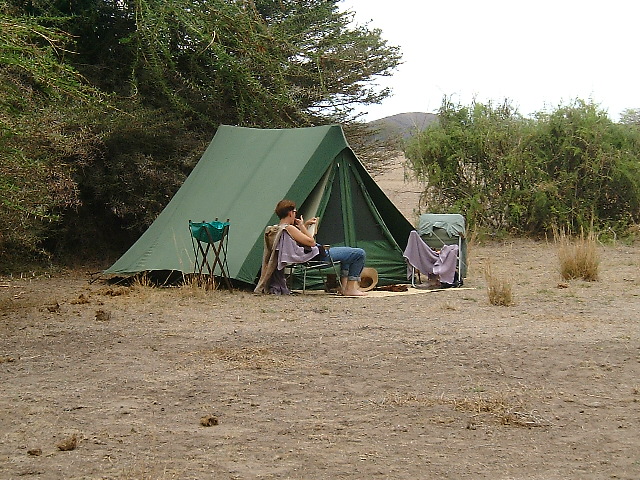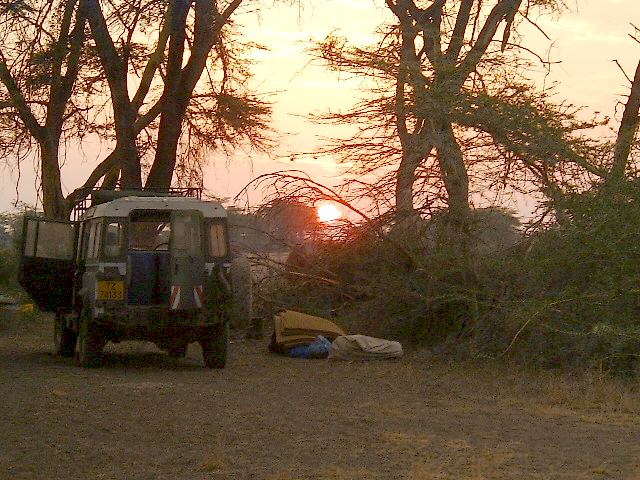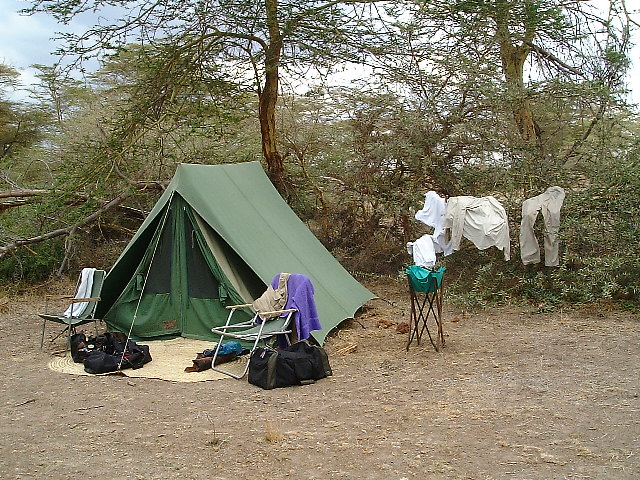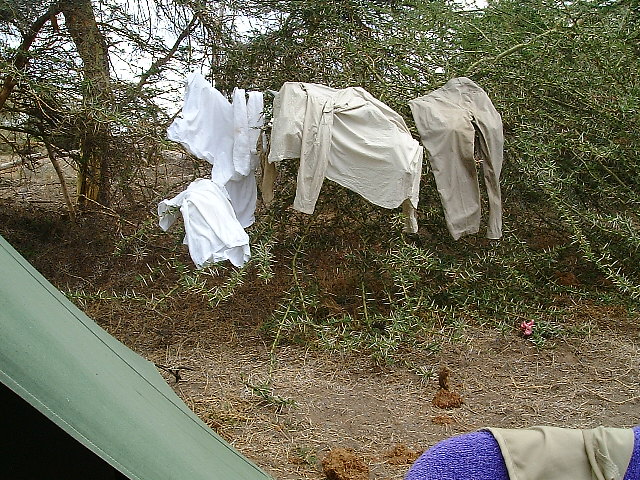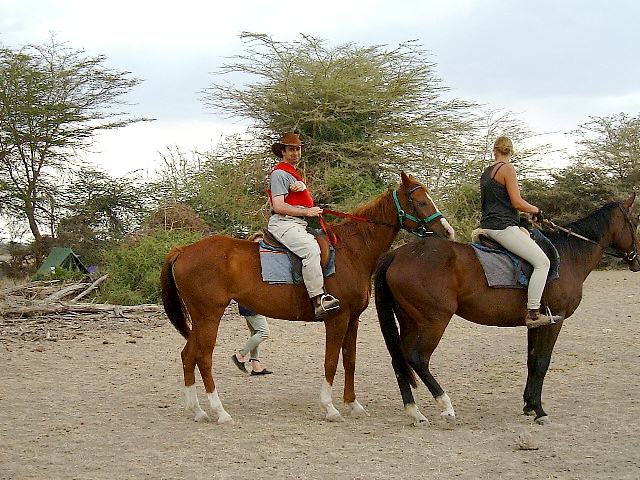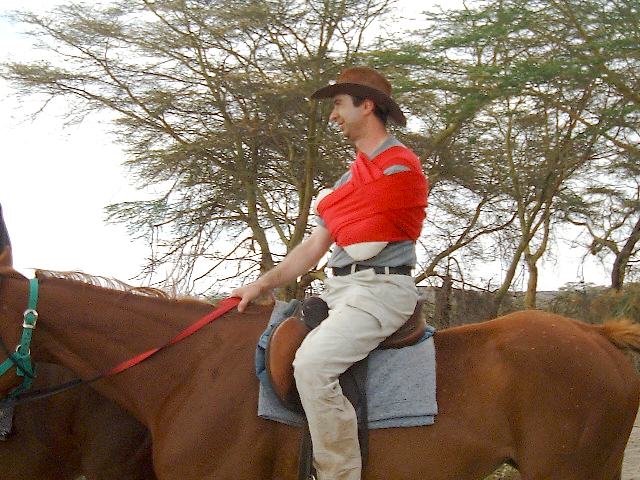Part 1, the Horse Safari By John L. Fuhring PAGE 5 As we rode along, way off in the distance to the north of us, I noticed an old steel tower . I'd say more of it later, but at the time it seemed very curious to see something like that out here. Heading in an easterly direction, the groves of trees were getting thicker and greener although the surface of the ground seemed to be very dry. The tree species were dominated by the "Yellow Fever Tree." The Yellow Fever Tree (AKA the Fever Tree) is a handsome thorn tree that can be found growing larger than most other species of thorn trees. The bark of these trees is yellow to lime green - yellow and the thorns are large and sharp, but the branches are lacking in those terrible mini thorns. I'm told that they grow extremely fast and a large 30 foot tree can grow from a sapling in just three years or so. They must be extremely eatable and nutritious because the elephants just love to tear them apart and eat them - thorns and all. I've seen elephants of all sizes stuff Fever Tree fronds in their mouths without bothering in the slightest about the thorns. Where there are Fever Trees, so too there are elephants (mostly). By the way, Yellow Fever Trees got their name because many, many years ago (before Pasteur developed the germ theory of disease), people actually believed that you got the yellow fever disease from those trees. I believe the association came about because those trees grow in areas that are swampy or otherwise wet with ground water. These trees also grow in tropical or semi-tropical areas. When you add damp and tropical together, you get a perfect breeding ground for yellow fever and the trees are simply innocent bystanders who got blamed by an unfair association. For those of you who might be curious about the "pachyderm fecal matter" that I mentioned in passing, permit me to digress to the subject of (what I'll call) Poopology (AKA scatology in educated circles). Let me start by saying that all the elephant stuff I saw was made up of very lightly digested woody strips and fiber (mostly from the Fever Trees). I think that animal poop can be classified on a continuum of nastiness from human to pig, to cat, to chicken, to dog, to goat, to cow and finally way at the end - hardly qualifying as nasty at all - is horse poop. Well, I'm starting to think that maybe elephant poop might be even less nasty than horse poop, yes, I'm sure of it. There is no smell (I could detect), it isn't runny or messy and even when fresh, it is pretty dry. It looks very much like fiberboard or the shredded wood fiber they used to pack things in, only coarser. This stuff would make an absolutely great cooking fuel, but in East Africa, nobody cooks on anything except charcoal. For that matter, pressed together into thin sheets, it would make a great building material (well, maybe). Since writing the above, my sister Mary Ann has informed me that elephant poop is commercially processed into a special paper and sold to tourists in South Africa. She says that this paper isn't cheap. Can't help but think that money, some people's birth certificates and other records, repair contracts, diplomas from off campus colleges and especially documents dealing with HMO's should be printed on that kind of paper - after all, most of that kind of stuff "ain't worth shit" anyway. Later that afternoon, after this most fun ride through a "real" part of Africa, we spotted our home for the next two nights. Jan had chosen a great site for us - I'm calling this place "Camp Ndovu" (Camp Elephant). We were located in an open grove of Fever Trees that provided a kind of a protected perimeter, but still had plenty of room for the horses, the trucks (oh sorry, I meant the lorries), our tents, the shower and bath, the bonfire and all the other comforts of a deluxe bush camp. It was a nice place and we could have stayed there a week or more (except we'd have run out of food and water). When we first arrived, vervet monkeys were climbing around in the trees and I thought they might become pests, but they soon disappeared altogether (probably they were afraid we might be poachers). They were fun to watch, but I was glad when they were gone because I was thinking of all the gruesome "primate viruses" mentioned in that damned book my buddy Dave gave me (thanks again Dave!).
This camp was charming except that Jan located the shower too near the camp (probably for safety reasons) and not as private as I would have preferred it. I waited until sundown to take a shower and then discovered that it was a little scary being out there in my "birthday suit" with nothing to protect my likewise naked feet from all the thorns. Here we really felt the presence of wild animals. As it was getting darker and darker, those thoughts certainly did intrude into one's mind. Well, I finished my shower and made it back to the main camp with all my clothes on. I was so glad I didn't have to make a quick sprint back to camp in my birthday suit and bare feet because it would have been a most unpleasant experience (and not just for me either - eeek!!). Back in the safety of camp I settled into the pleasant wait for supper around a big campfire as the African Night quickly fell (click). It was dark by now and I was sipping on something nice when we were startled by the trumpeting of a bull elephant. This trumpeting was loud and angry and what's more, it was very, very close. I've heard elephants trumpet in plenty of "jungle movies" and wasn't concerned at first, but I noticed that Jan and the Native guys were very agitated. They quickly set out more kerosene lanterns around the camp's perimeter. Soon the Native guys were shoveling glowing coals out of the bonfire and using them to start picket fires all around the camp. My theory is that we must have taken over some elephant guy's favorite "stomping grounds" and he was pissed when he returned home after a hard day. We waited breathlessly to see if a mad elephant would come charging into camp with some poor hapless native rolled in his trunk (like in that Tarzan movie), but evidently, the lights and the fires did the trick because we heard nothing further from Ndovu bwana (Mr. Elephant) that evening. The truth is, after things calmed down, we were quite relieved that he didn't take the trouble to come into camp to register his complaint. If these were his "stomping grounds" at least we were spared being stomped on that night. As I mentioned earlier, I'm somewhat socially challenged so I went to bed early (as usual) and slept without a care until near dawn. Again I got up so I could take a picture of the sun coming up and maybe get a glimpse of Kilimanjaro. I had some of that excellent Tanzanian coffee, cereal with milk, tropical fruit and scrambled eggs with toast and jam for breakfast. Except for the Safari staff, I was usually the first one up (my sister Mary Ann will find that hard to believe). The horses were saddled up and we took an early safari ride to explore our surroundings.
We rode out to where we had first sighted that tall metal tower I mentioned before. It turned out that this area had been a large open mine where a special kind of valuable clay (meerschaum) had once been mined. Have no idea why the mine was closed, but all that remained of the operation was ruins of once nice dwellings, some machinery, a tall steel tower, mounds of white meerschaum clay and numerous pits filled with this pastel green water. The water was loaded with minerals that it was completely unfit for animals or people to drink in that thirsty land. The ground water that filled these pits and what had turned the volcanic dust to clay over the millennia must be the result of runoff from Mt. Kilimanjaro to the south. While we were there we ran into a small group of young Masai warriors who were dressed in their very best and carried some very fine spears. These guys were quite friendly and had a little chat (not in English) with us. I sure wish I could show you a picture of those guys because they looked great. I know this sounds stupid, but I didn't even ask about taking pictures because I didn't want to embarrass myself or the safari people with what might be a forbidden request. Charlie and Eva, the two safari girls, dropped their camera and went back to look for it. I didn't have my GPS on so I couldn't have led them back along our trail. They never found the camera, but it was a cheap one and some Masai kid is probably enjoying it as I write. We never saw the girls again until we got back to camp. We returned to camp for lunch and had the option to spend the remainder of the day in camp. I was running out of clean clothes and needed to do some laundry so this was the perfect opportunity to scrub my stuff. Long ago (on a trip through Eastern Europe and Russia) I knew I'd have to do my own laundry and had the brilliant idea to bring a small bottle of dish washing detergent. Dish washing detergent is far, far superior to bar soap or any other kind of cleaner for those who must do their own laundry. It has powerful degreasing and cleaning actions, it's easy on the skin and it rinses out really easily. It leaves clothes feeling soft, fresh and clean. Bar soap, on the other hand, leaves a greasy film on clothes, dries out the hands and is hard to rinse out. I requested two buckets of hot water from Jan (one for the wash and one for the rinse water) and proceeded to wash a shirt, several sets of underwear and socks and a pair of very dirty riding pants. The low branches of small Fever Trees worked wonderfully as a close line since it was absolutely impossible for the clothes to become dislodged from the thorns and fall to the ground - even if the wind started blowing. Within a couple of hours my clothes were clean and dry.
That same afternoon John went on his first riding safari all done up in polo wraps. As can be seen in the photo, John was all bundled up in these bright red wraps. This arrangement immobilized his broken arm and its heavy plaster cast. This first essay on horseback was really an experiment and the ride was limited to just a few people to see how he'd do. It worked out really well and from then on he rode with us in the afternoons. By the way, the Masai really love the color red and they always seemed to pay special attention as John rode by in his red wraps. Made me really wish I would have brought my scarlet hunt coat along just to impress the natives.
After my washing was done, Jan suggested that I climb a large and high kopje a mile or so from the camp. Sounded good to me so I started out for the outcropping with my camera. We had an older Masai warrior who was hired to represent our safari to the Masai in the area and to guard our horses from wild animals at night. Jan suggested that I let this guy guide me, but I said that thought I'd rather be alone. Wisely, Jan sent this guy after me and it was a good thing too because I promptly got myself into some real trouble. Please
continue on to Page 6 of this story
When you have read as much as you like and before you leave, I would appreciate reading your comments Please sign my guestbook before leaving. If you would like to skip ahead, you can return to the Africa Adventures selection page. |
